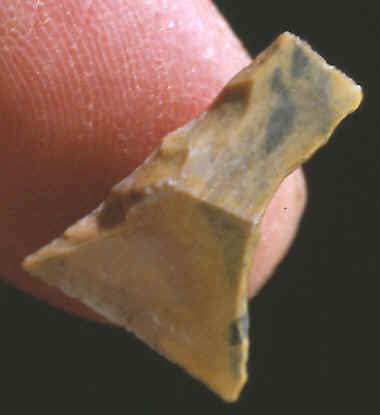|
Transverse arrowheads
were made from short snapped off segments of core blades. Each segment
was finished by steeply pressure flaking two edges to form the
projectile point. Both of the original core blade edges were left
unaltered. The smaller edge was used for hafting to the arrow shaft and
the wider edge for cutting and piercing at the end of the arrow.
|
|
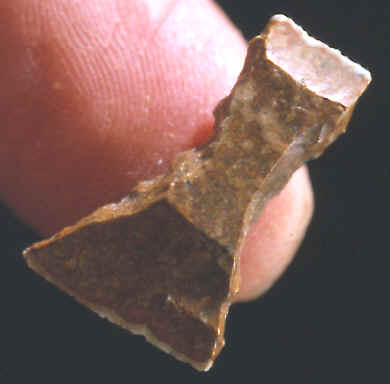
CLICK ON
PICTURE FOR LARGE TRIPLE IMAGE
TRANSVERSE ARROWHEAD
MESOLITHIC & EARLY
NEOLITHIC PERIOD
NORTH AND WESTERN EUROPE
PRIVATE COLLECTION
This transverse arrow point is made of a dark heavily patinated
chert. Three previous blade removal scars can be seen on this side
which is a clear indication that it was made from a core blade. It measures 7/8 of an inch (2.3 cm) long and 9/16 of an inch
(1.4 cm) wide. |
|
|
Core blades can be used
to make a wide range of stones tools. That's why the technology was so
successful for such a long period of time. The common use of core blades
in Europe began well over 30,000 years ago during the Aurignacian period. Transverse
arrow points were
an invention that was developed out of the microlithic industry. The
microlithic industry is a core and blade technology most characteristic
of the Mesolithic period 8,000 to 5,000 years ago.
|
|
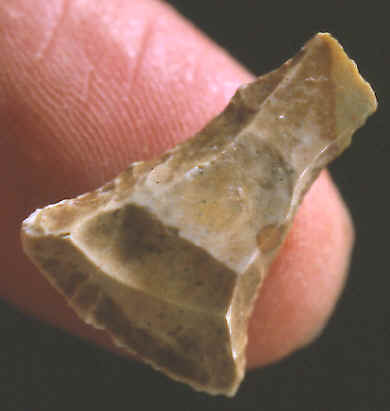
CLICK ON
PICTURE FOR LARGE TRIPLE IMAGE
TRANSVERSE ARROWHEAD
MESOLITHIC & EARLY
NEOLITHIC PERIOD
NORTH AND WESTERN EUROPE
PRIVATE COLLECTION
This transverse arrowhead is made of a very heavily patinated
material that may be Danish flint. It measures 13/16 of an inch (2.1
cm) long and 5/8 of an inch (1.5 cm) wide. |
|
|
Transverse arrowheads
are categorized into many different types. Some are described as
parallel sided, diverging, straight or slightly concave sided, very
concave sided with out-turned edge corners, slightly oblique edge, and
even very large transversal weapon head that measure between 4 and 5 cm.
|
|
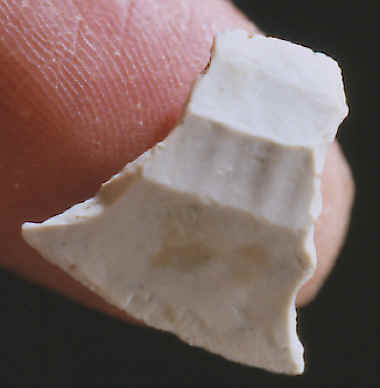
CLICK ON
PICTURE FOR LARGE TRIPLE IMAGE
TRANSVERSE ARROWHEAD
MESOLITHIC & EARLY
NEOLITHIC PERIOD
NORTH AND WESTERN EUROPE
PRIVATE COLLECTION
This transverse arrowhead is actually wider than it is long. The
wide edge, which is the original core blade's edge, is the end of
the arrow point that would pierce the intended target. This edge
measures almost 3/4 of an inch (1.9 cm) wide. This point is made of
what appears to be Danish flint. It measures 11/16 of an inch (1.7
cm) long. |
|
|
Very small arrowheads
were widely used during the Mesolithic period. Most examples are less
than 1 inch (2.5 cm) long. Six out of the 18 examples illustrated in
this article are slightly over 1 inch (2.5 cm) long but out of the
collection of 53 from which they were borrowed only 11 are over 1 inch
(2.5 cm) long.
|
|
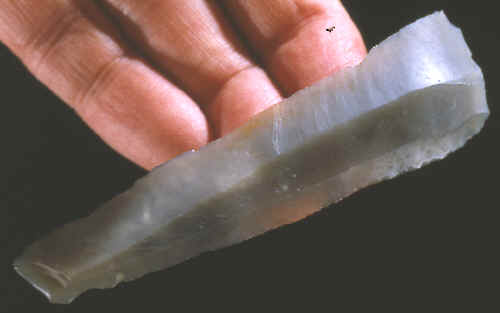
CORE BLADE
MESOLITHIC & EARLY
NEOLITHIC PERIOD
NORTH AND WESTERN EUROPE
PRIVATE COLLECTION
The core blade illustrated here is a fairly typical example. Several
previous blade removal scars can be seen on the surface. Transverse
arrowheads were made from core blades like this one. They were made
by snapping off small rectangular segments that still retained both
edges of the blade. The sides were then steeply pressure flaked into
shape with one end wider than the other. One core blade could produce several arrow points. |
|
|
It has been suggested
that because so many of the microlith arrowheads were small that they
must have been used differently than they are today. They may have been
designed to remain in the animal once it was shot. The reason for this
might be that they were tipped with poison and the longer the arrows remained in the animal
the longer the poison would dissolve into the bloodstream.
|
|
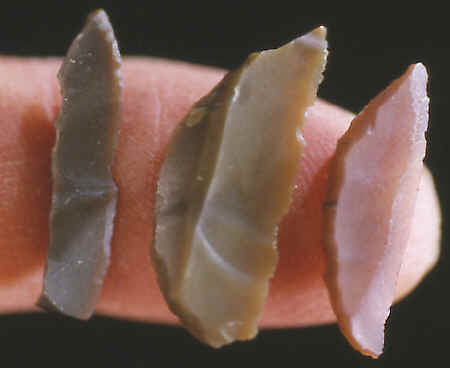
MICROLITHS
MESOLITHIC PERIOD
NORTH AND WESTERN EUROPE
PRIVATE COLLECTION
This picture shows three typical examples of microliths from the
Mesolithic period in northern Europe. They were made from core
blades just as transverse arrowheads were. The three microliths
pictured here may have been used as side-blades in harpoons, sickles
or even on arrows.
Microlithic industries, in different forms, are can be
found all over the world except for south east Asia and Oceania
where it appears to be lacking. They can be found in Africa,
Australia, north east Asia and the Arctic. In North America they
appear in the Arctic Small Tool Tradition and as micro-drills
in the Mississippi Valley at Cahokia. They even appear in some assemblages
in South America. They date to various periods in the archaeological
record beginning in the Late Paleolithic to the Late Stone Age. |
|
|
Trapezoidal
shaped transverse
points are peculiar looking arrowheads. Nothing like them
was ever developed in any of the Stone Age cultures of North America,
even though countless millions of arrow points were produced in an
endless variety of styles. Most people, if they saw one laying on the
ground, would never suspect that such a plain looking flake of stone
would have tipped the ends of arrows.
|
|
"REFERENCES"
1921,
"A Text-Book of European Archaeology", Vol. I The Paleolithic
Period, by R. A. S. Macalister, pp. 535, 536.
1928, "Our Prehistoric Ancestors", by Herdman Fitzgerald Cleland,
pp. 81-84.
1959, "The Prehistory of Southern Africa", by J. Desmond Clark,
p. 195.
1966, "Aboriginal Man In South And Central Australia", Part 1,
by B.C. Cotton, pp. 204-208.
1988, "Encyclopedia of Human Evolution & Prehistory," by Ian
Tattersall, Eric Delson & John Van Couvering, pp. 335-338.
1996, "The Oxford Companion To Archaeology", by Brian M. Fagan,
pp. 467-469.
|
|
HOME
ORDERING |
